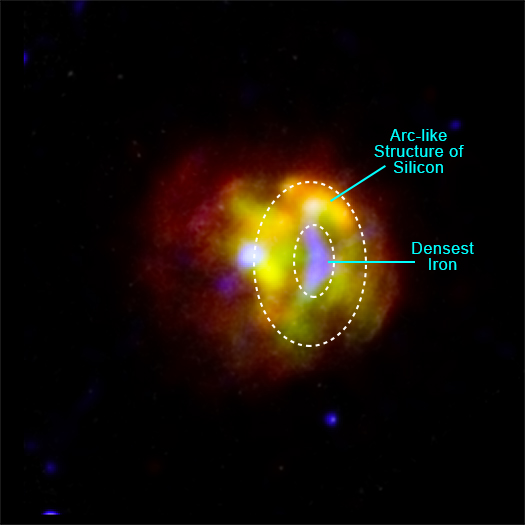17.10.2021

- The supernova remnant G344.7-0.1 is across the Milky Way about 19,600 light years from Earth.
- It belongs to a class of supernovas called "Type Ia" that can result from a white dwarf accumulating material from a companion star until it explodes.
- A new composite image contains X-rays from Chandra (blue), infrared data from Spitzer (yellow and green) and radio data from two telescopes (red).
- Chandra's data reveal different elements such as iron, silicon, sulfur and others found in the aftermath of the stellar explosion.
White dwarfs are among the most stable of stars. Left on their own, these stars that have exhausted most of their nuclear fuel — while still typically as massive as the Sun — and shrunk to a relatively small size can last for billions or even trillions of years.
However, a white dwarf with a nearby companion star can become a cosmic powder keg. If the companion's orbit brings it too close, the white dwarf can pull material from it until the white dwarf grows so much that it becomes unstable and explodes. This kind of stellar blast is called a Type Ia supernova.
While it is generally accepted by astronomers that such encounters between white dwarfs and "normal" companion stars are one likely source of Type Ia supernova explosions, many details of the process are not well understood. One way to investigate the explosion mechanism is to look at the elements left behind by the supernova in its debris or ejecta.
This new composite image shows G344.7-0.1, a supernova remnant created by a Type Ia supernova, through the eyes of different telescopes. X-rays from NASA's Chandra X-ray Observatory (blue) have been combined with infrared data from NASA's Spitzer Space Telescope (yellow and green) as well as radio data from the NSF's Very Large Array and the Commonwealth Scientific and Industrial Research Organisation's Australia Telescope Compact Array (red).
Chandra is one of the best tools available for scientists to study supernova remnants and measure the composition and distribution of "heavy" elements — that is, anything other than hydrogen and helium — they contain.
Astronomers estimate that G344.7-0.1 is about 3,000 to 6,000 years old in Earth's time frame. On the other hand, the most well-known and widely-observed Type Ia remnants, including Kepler, Tycho, and SN 1006, have all exploded within the last millennium or so as seen from Earth. Therefore, this deep look at G344.7-0.1 with Chandra gives astronomers a window into an important phase later in the evolution of a Type Ia supernova remnant.
Both the expanding blast wave and the stellar debris produce X-rays in supernova remnants. As the debris moves outward from the initial explosion, it encounters resistance from surrounding gas and slows down, creating a reverse shock wave that travels back toward the center of the explosion. This process is analogous to a traffic jam on a highway, where as times passes an increasing number of cars will stop or slow down behind the accident, causing the traffic jam to travel backwards. The reverse shock heats the debris to millions of degrees, causing it to glow in X-rays.
Type Ia remnants like Kepler, Tycho and SN 1006 are too young for the reverse shock to have time to plausibly travel backwards to heat all of the debris in the remnant's center. However, the relatively advanced age of G344.7-0.1 means that the reverse shock has moved back through the entire debris field.
A separate color version of only the Chandra data shows X-ray emission from iron (blue) and silicon (red) respectively, and X-rays produced by the acceleration of electrons as they are deflected by the nuclei of atoms that are positively charged (green). The region with the highest density of iron and the arc-like structures of silicon are labeled.
The Chandra image of G344.7-0.1 shows that the region with the highest density of iron (blue) is surrounded by arc-like structures (green) containing silicon. Similar arc-like structures are found for sulfur, argon, and calcium. The Chandra data also suggests that the region with the highest density iron has been heated by the reverse shock more recently than the elements in the arc-like structures, implying that it is located near the true center of the stellar explosion. These results support the predictions of models for Type Ia supernova explosions, which show that heavier elements are produced in the interior of an exploding white dwarf.
This three-color Chandra image also shows that the densest iron is located to the right of the supernova remnant's geometric center. This asymmetry is likely caused by gas surrounding the remnant being denser on the right than it is on the left.
A paper describing these results was published in the July 1st, 2020 issue of The Astrophysical Journal and is available online. The authors of the study are Kotaro Fukushima (Tokyo University of Science, Japan), Hiroya Yamaguchi (JAXA), Patrick Slane (Center for Astrophysics | Harvard & Smithsonian), Sangwook Park (University of Texas, Austin), Satoru Katsuda (Saitama University, Japan), Hidetoshi Sano (Nagoya University, Japan), Laura Lopez (The Ohio State University, Columbus), Paul Plucinsky (Center for Astrophysics), Shogo Kobayashi (Tokyo University of Science), and Kyoko Matsushita (Tokyo University of Science). The radio data were provided by Elsa Giacani from the Institute of Astronomy and Space Physics, who led a study of G344.7-0.1 published in 2011 in the journal Astronomy and Astrophysics.
NASA's Marshall Space Flight Center manages the Chandra program. The Smithsonian Astrophysical Observatory's Chandra X-ray Center controls science from Cambridge Massachusetts and flight operations from Burlington, Massachusetts.
Quelle: NASA

